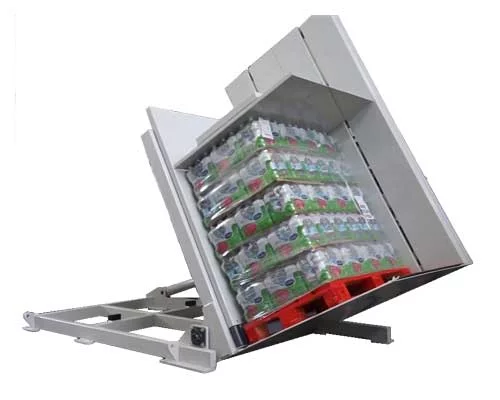Pallet Inverter Safety Tips for Russia Plants Facing Rugged Designs for Cold Storage and High Throughput
Running a high-throughput facility in the harsh Russian climate presents a unique set of problems. You need equipment that can keep up with demanding production schedules, but the extreme cold can cause standard machinery to fail. I have seen it happen. A hydraulic line becomes brittle and cracks. A sensor freezes over and gives a false reading. The result is always the same: costly downtime, damaged products, and a serious risk to your workers' safety. You start to wonder if any equipment can truly withstand these conditions, or if you're doomed to a cycle of constant repairs and safety incidents. But there is a solution. It lies in choosing equipment that is not just built, but engineered specifically for your environment. A pallet inverter designed with the Russian winter in mind is more than a piece of steel; it's the core of a safe and efficient operation.
The most effective safety tips for pallet inverters in Russian plants involve a two-pronged approach: selecting equipment with rugged, cold-weather specifications and implementing strict operational protocols. This means choosing inverters built with low-temperature steel, using arctic-grade hydraulic fluids and electronics, and ensuring they have robust safety features like light curtains and glove-friendly E-stops. This must be paired with rigorous operator training focused on cold-weather hazards and consistent pre-use inspections.
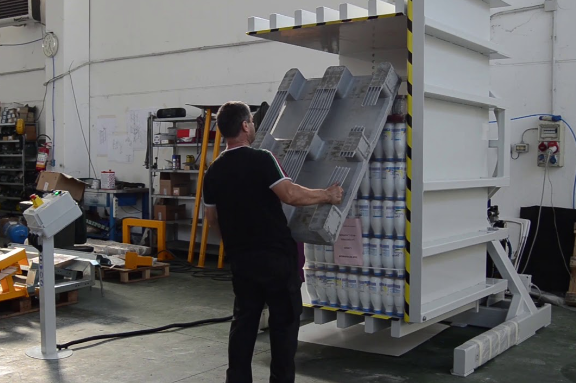
I've spent my entire career in the packaging machine industry, from my early days on the factory floor to building my own company, SHJLPACK. I’ve helped countless clients, like Javier Morales who runs a massive steel mill, find the right equipment for demanding environments. They understand that a machine is an investment, and it has to deliver performance, reliability, and above all, safety. The challenges you face in a Russian cold storage facility are intense, but they can be overcome with the right knowledge and the right engineering. Let’s dive deeper into the specific features and practices that separate a standard machine from one that will thrive in your plant.
How Can You Ensure Pallet Inverter Components Withstand Russian Winter Temperatures?
You know the feeling. The temperature outside plummets, and you start getting calls from the floor. A machine is sluggish. A component has failed. Production has stopped. In places with extreme cold like Russia, standard industrial equipment is pushed beyond its limits. Hydraulic oil thickens like molasses, steel can become brittle as glass, and electronic sensors can give up completely. This isn't just an inconvenience; a sudden failure of a pallet inverter holding a one-ton load is a disaster waiting to happen. The solution is not to hope for the best. The solution is to demand components and materials specifically engineered for sub-zero operation from the very start.
To guarantee a pallet inverter can function reliably in the Russian winter, you must specify components designed for extreme cold. This starts with the frame, which should be made from special low-temperature steel that resists becoming brittle. The entire hydraulic system needs to be equipped with arctic-grade oil, hoses, and seals that remain flexible and effective below freezing. Finally, all electronic controls and sensors must have a wide operating temperature range and be housed in heated or insulated enclosures to prevent condensation and failure.
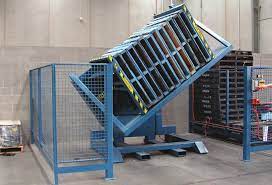
I remember a client in Siberia who was struggling with this exact issue. Their pallet inverter, a standard model, was failing multiple times each winter. We didn't just sell them a new machine. We worked with them to understand the specific challenges of their unheated warehouse. We walked through the engineering choices that make a machine "cold-proof." It’s about more than just a label; it’s about a deep understanding of material science and operational physics.
Material Science in the Cold
The very foundation of your machine, its steel frame, is the first point of vulnerability. Standard carbon steel can undergo a "ductile-to-brittle transition" at low temperatures. This means a frame that is strong and flexible at 20°C could fracture from a minor impact at -20°C. That's why we must insist on steel grades that are certified for low-temperature service. These steels have specific alloys and have undergone heat treatments to maintain their ductility in the cold. When talking to a manufacturer, you should ask for the material specifications and impact test results (like a Charpy V-notch test) at your facility's lowest expected operating temperature. The same principle applies to welding. The welding process and filler materials must also be rated for low-temperature applications to ensure the welds are as strong as the steel they join.
The Heart of the Machine: The Hydraulic System
A hydraulic system is the muscle of most pallet inverters. But in the cold, standard hydraulic oil thickens. Its viscosity increases dramatically. This makes the machine slow and unresponsive. It also puts immense strain on the pump motor, leading to premature burnout. Simply put, the machine can't do its job. The solution is to use a synthetic, arctic-grade hydraulic fluid with a very low pour point and a stable viscosity index. This ensures the fluid flows easily even when it's freezing outside. But the oil is only part of the system. Hydraulic hoses and seals made from standard rubber will become hard and crack. You must use hoses and seals made from materials like low-temperature nitrile or other specialized elastomers designed to remain flexible and prevent leaks in the bitter cold.
The Brains of the Operation: Electronics and Controls
Electrical components are just as vulnerable. Condensation can form inside control cabinets as temperatures fluctuate, leading to short circuits. Many standard LCD screens and sensors simply stop working below a certain temperature. A robust cold-weather design addresses this head-on. The main control cabinet should be, at a minimum, NEMA 4 rated (to keep out moisture) and ideally equipped with a small, thermostatically controlled heater and insulation. This creates a stable micro-environment for the PLC, VFDs, and power supplies. All sensors, like photo-eyes and proximity switches, must be specified with an operating range that exceeds your environmental conditions. For operator interfaces, rugged buttons that can be used with thick gloves are far superior to touch screens that may not respond to a gloved hand or function poorly in the cold.
| Component | Standard Specification | Cold-Weather Specification | Why It Matters |
|---|---|---|---|
| Frame | A36 Carbon Steel | Low-Temp Alloy Steel (e.g., A516) | Prevents brittle fracture and structural failure. |
| Hydraulic Oil | ISO 32/46 Mineral Oil | Synthetic Arctic-Grade Oil | Ensures fluid flow and prevents pump strain. |
| Hoses/Seals | Standard Nitrile Rubber | Low-Temp Nitrile/Elastomers | Prevents leaks and catastrophic hose failure. |
| Control Cabinet | NEMA 12 | NEMA 4 with Heater/Insulation | Protects sensitive electronics from cold and moisture. |
| Sensors | 0°C to 50°C Range | -40°C to 50°C Range | Guarantees reliable machine operation and safety. |
What Key Design Features Make a Pallet Inverter Truly Rugged for High-Throughput Operations?
In a high-throughput environment, a pallet inverter isn't used once an hour. It's used once a minute. This constant, heavy-duty cycling puts enormous stress on every single part of the machine. I've visited factories where a "standard duty" machine looks old after just one year. You see cracked welds, bent frames, and leaking hydraulics. The problem is that many machines are designed for intermittent use, not the relentless pace of a 24/7 operation. This leads to constant breakdowns, which means lost production, frustrated workers, and maintenance costs that eat away at your profit. A truly rugged design isn't just about using thicker steel. It's about a complete design philosophy that anticipates and mitigates the stresses of continuous, heavy work.
A truly rugged pallet inverter is identified by its over-engineered structural and mechanical components. Look for a frame constructed from thick, solid steel plates with continuous welds, not a lighter, bolted-together frame. The hydraulics or motor drive system must be oversized for the load capacity to avoid constant strain. Most importantly, check the wear components: the pivot points, bearings, and guides. In a rugged machine, these will be significantly larger and made of higher-quality, hardened materials to withstand the friction and force of thousands of cycles per day.

I've always believed in building things to last. It’s a principle I learned early in my career and one I built my company on. A rugged machine costs more upfront, but it pays for itself many times over in uptime and longevity. It's the difference between buying a professional tool and a hobbyist one. Both might do the job at first, but only one will stand up to the rigors of professional, daily use. Let's break down where that "professional-grade" quality comes from.
The Backbone: Frame and Structure
The structural integrity of the pallet inverter is paramount. A high-throughput machine is subject to immense dynamic forces during every cycle. A lightweight, bolted frame will inevitably loosen and flex over time, leading to misalignment and fatigue failures. A superior design uses a heavy-duty frame made from thick steel plates, often 20mm or more, that are fully welded. This creates a rigid, unified structure that can absorb the forces of clamping and rotation without distortion. Good manufacturers use tools like Finite Element Analysis (FEA) during the design phase. This computer simulation allows engineers to "see" stress points in the frame under load and add reinforcements before a single piece of steel is ever cut. When you look at a machine, look at the size of the main pivot points and the quality of the welds. These are tell-tale signs of a rugged design.
The Muscle: Power and Clamping System
The system that clamps and inverts the load must be powerful and reliable. For hydraulic systems, this means using not just one, but often two clamping cylinders. Using dual cylinders ensures that pressure is applied evenly across the entire surface of the load. This is crucial for stability and prevents product damage. It also reduces the strain on any single cylinder. The hydraulic power unit itself should be a "heavy-duty" model, designed for a high duty cycle, meaning it can run continuously without overheating. If the machine is electric, the same principle applies. The motors and gearboxes should be oversized for the task. Ask the manufacturer for the motor's duty rating; you should be looking for a continuous-duty rating for high-throughput applications.
The Joints: Wear Components
The parts that move are the parts that wear out. In a pallet inverter, this means the main pivot bearings, guide rollers, and slide blocks. In a standard machine, these are often the bare minimum size required. In a rugged machine, they are intentionally oversized. Larger bearings can handle higher loads and dissipate heat more effectively, leading to a much longer service life. High-quality, sealed-for-life bearings reduce maintenance needs. Guide rollers should be made of hardened steel or a durable polymer like UHMW-PE to resist wear from constant motion. Furthermore, a well-designed machine makes these wear parts easy to access for inspection and replacement. Because even the best parts will eventually wear out, and minimizing the time it takes to replace them is key to maintaining high throughput.
| Feature | Standard-Duty Design | Rugged High-Throughput Design | The Advantage |
|---|---|---|---|
| Frame | Bolted, lighter gauge steel | Fully welded, thick steel plate | Superior rigidity, no loosening, long life. |
| Clamping | Single hydraulic cylinder | Dual hydraulic cylinders | Even pressure, load stability, less strain. |
| Main Bearings | Standard size, open | Oversized, sealed-for-life | Higher load capacity, less maintenance. |
| Guide System | Metal-on-metal slides | Hardened steel rollers or UHMW pads | Lower friction, longer wear life, smoother operation. |
| Duty Cycle | Intermittent use | Continuous 24/7 rating | Prevents motor/pump overheating and failure. |
What are the Most Critical Safety Protocols for Operating Pallet Inverters in Cold, Fast-Paced Environments?
In a fast-paced plant, speed can become the enemy of safety. Operators are under pressure to meet targets, and this can lead to shortcuts. Now add the challenges of a cold environment: workers are wearing bulky gloves, footing can be slippery, and the cold itself can be a distraction. The problem is that a pallet inverter is a powerful machine. A moment of inattention or a procedural error can have devastating consequences. An operator could be caught in a moving part, or an unstable load could fall. You worry constantly about your team's well-being. The solution isn't to slow down production. It's to build a robust safety system around the machine—a system that combines physical guards, smart technology, and ironclad procedures.
The most critical safety protocols for pallet inverters are a layered defense system. The first layer is physical guarding, such as safety fencing with interlocked gates that shut the machine down if opened. The second layer is presence-sensing technology, like light curtains at the loading area, which stop the machine if an operator crosses the beam. The third layer is procedural, including mandatory daily pre-operation checklists, strict adherence to load capacity limits, and comprehensive operator training with a specific focus on cold-weather hazards and emergency responses.
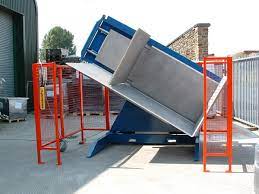
Safety has always been my number one priority. I learned as a young engineer that a productive plant is a safe plant. You can't have one without the other. When I started SHJLPACK, I made it our mission to build machines where safety is not an optional extra; it's integrated into the core design. I've seen firsthand how a well-designed safety system doesn't just prevent accidents; it gives operators the confidence to work efficiently, knowing they are protected. Let's look at how these layers of protection work together.
Engineered Safety: Making the Machine Foolproof
The best safety system is one that doesn't rely on human behavior alone. That's where engineered controls come in.
- Physical Guarding: The entire machine work cell should be enclosed by safety fencing that is at least two meters high. Any access gates must be equipped with safety interlock switches. If a gate is opened while the machine is running, the interlock immediately cuts power to the machine's motion systems, bringing it to a safe stop.
- Presence Sensing: For the areas where forklifts need to load and unload pallets, physical gates aren't always practical. This is where light curtains or laser area scanners are essential. These devices create an invisible field of light. If any object—a person, a forklift, a stray pallet—breaks this field during the machine's operating cycle, it stops instantly.
- Emergency Stops (E-Stops): E-stop buttons must be placed at all operator stations and key access points around the machine. In a cold environment, these must be large, mushroom-head style buttons that are easy to press with a gloved hand. They should not be small, recessed buttons that are hard to activate in an emergency.
- Hydraulic Safety: For hydraulic machines, a critical feature is a velocity fuse or load-holding valve on the clamping and tilting cylinders. If a hydraulic hose were to burst, this valve would automatically lock the cylinder in place, preventing the load from falling.
Procedural Safety: The Rules of the Road
Engineered controls are vital, but they must be supported by clear and enforced procedures.
- Lockout/Tagout (LOTO): This is non-negotiable. Before any maintenance, cleaning, or jam-clearing, the machine must be fully de-energized and locked out according to a formal LOTO procedure. Every authorized employee must have their own lock and key.
- Daily Inspections: The operator must perform a documented pre-shift inspection before using the machine. This checklist should include checking the condition of guards, verifying the function of light curtains and E-stops, and looking for any hydraulic leaks or unusual noises.
- Load Integrity: Clear rules must be established for maximum load weight, height, and proper centering on the machine. Overloading or off-center loads are a primary cause of instability and accidents. In cold storage, this includes checking for loads that may have become unstable due to ice buildup.
Training: Empowering the Operator
The final layer is a well-trained operator. Training should not be a one-time event. It should be ongoing.
- Initial Training: Must cover the machine's full operation, all safety features, and all procedures, including LOTO and emergency response.
- Cold-Weather Specifics: Training must address the unique risks of the environment, such as how to check for ice on sensors, the danger of slippery floors around the machine, and the importance of wearing appropriate PPE that still allows safe operation of the controls.
- Drills: Periodically running drills, such as a simulated E-stop or a response to a light curtain trip, keeps skills sharp and ensures operators know how to react correctly under pressure.
| Safety Layer | Key Element | Purpose in Cold, Fast-Paced Environment |
|---|---|---|
| Engineered | Safety Fencing & Interlocks | Prevents accidental entry into the machine's motion zone. |
| Engineered | Light Curtains/Scanners | Protects the open loading area without hindering forklift access. |
| Engineered | Large, Gloved-Hand E-Stops | Ensures emergency shutdown is always possible, even with bulky PPE. |
| Procedural | Daily Inspection Checklist | Catches potential failures (e.g., a frozen sensor) before they cause an accident. |
| Procedural | Strict Load Centering Rules | Prevents tipping accidents, which are more dangerous with slippery floors. |
| Training | Regular Emergency Drills | Builds muscle memory so operators react correctly and quickly, not panic. |
How Do You Balance High Throughput Demands with Uncompromising Operator Safety?
Every plant manager feels this pressure. The head office wants higher numbers, faster cycle times, more output. But your safety manager is telling you to slow down and be careful. It feels like you have to choose between productivity and safety. If you push for speed, you risk an accident. If you prioritize safety with complex procedures, your throughput drops. This conflict creates stress for everyone, from the CEO to the forklift driver. But I am here to tell you that this is a false choice. The belief that speed and safety are opposites comes from an outdated way of thinking. The solution is to use automation to achieve both goals at the same time.
You can balance high throughput and operator safety by designing a workflow that minimizes manual interaction and maximizes machine efficiency. This is achieved by integrating the pallet inverter into a larger automated system with features like automatic infeed and outfeed conveyors and automated pallet stacking and dispensing. This transforms the operator's role from a hands-on laborer to a skilled supervisor, which is both safer and faster.
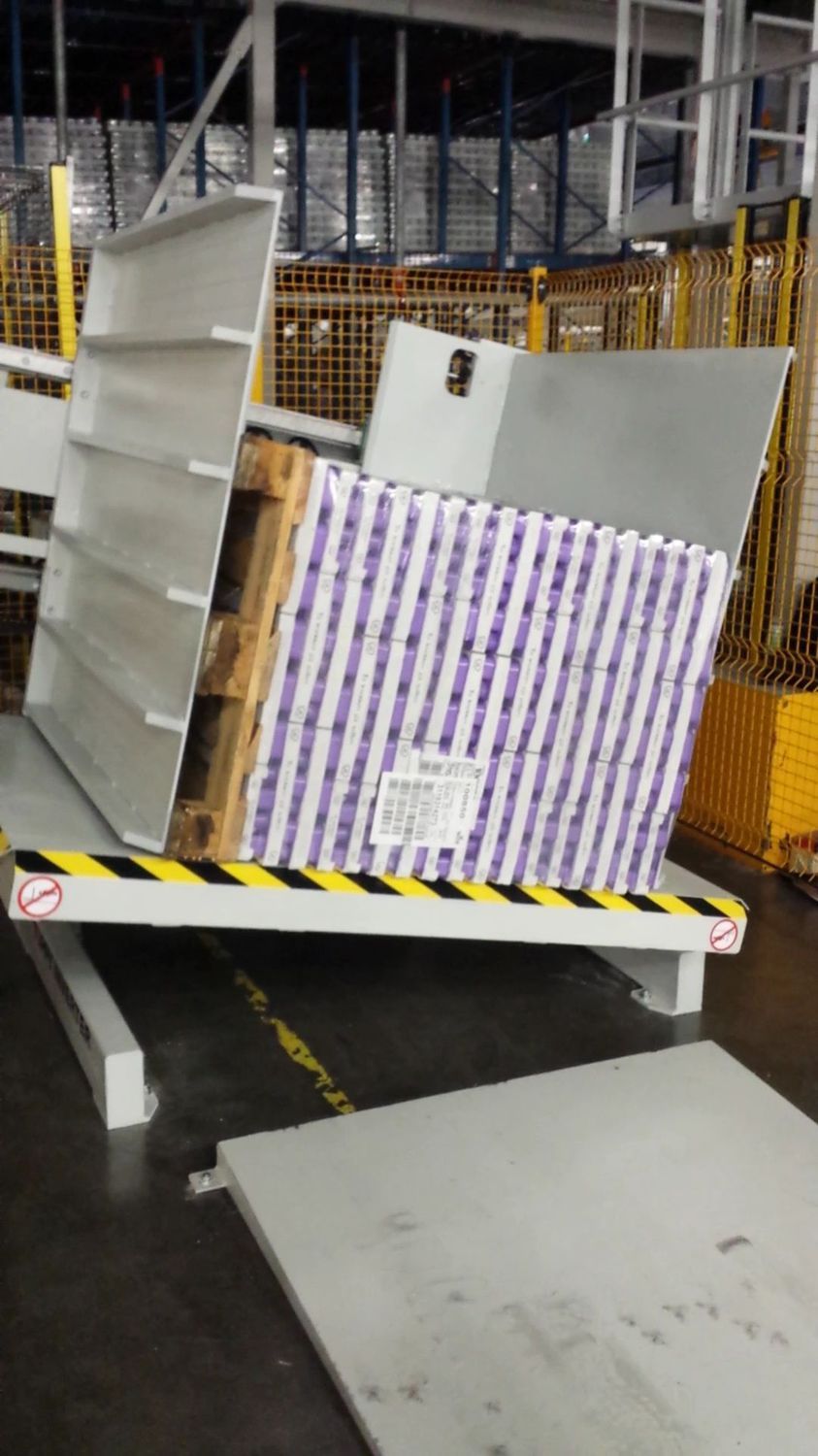
I remember working with a client, much like Javier, who ran a large beverage distribution center. They had a team of workers manually loading pallet inverters. Their throughput was limited, and they had a high rate of back injuries. They believed this was just the cost of doing business. We showed them a different way. We designed a fully automated system. A forklift driver would place a pallet on an infeed conveyor and then leave. The system would automatically convey the pallet into the inverter, clamp and invert it, and then discharge it onto an outfeed conveyor, where a new pallet from an automatic dispenser was waiting. The cycle time was cut in half, and the manual handling injuries dropped to zero. They didn't have to choose between speed and safety; they got more of both.
Automation: The Key to Speed and Safety
The biggest source of both slowdowns and accidents in a pallet-handling process is the manual interface. It takes time for a forklift to carefully place a pallet. It takes time for an operator to start the cycle. It creates opportunities for error. Automation removes these variables.
- Conveyor Integration: Connecting the pallet inverter with infeed and outfeed conveyors creates a continuous flow. The forklift driver can drop a pallet and immediately go get the next one, rather than waiting for the inverter's cycle to finish. This "decoupling" of the forklift and the inverter is a massive source of efficiency.
- Automatic Cycles: A PLC-controlled system with sensors can run the entire inversion process with the push of a single button. The machine automatically confirms the pallet is in position, clamps with the correct pressure, inverts, and unclamps. This is not only faster than manual jogging, but it's also more consistent and eliminates operator error.
- Pallet Dispensers and Stackers: Manually handling empty pallets is slow, strenuous, and a common source of injury. An automatic dispenser can feed a fresh pallet into the system instantly after inversion. A stacker can neatly accumulate the old pallets. This removes another manual task from the process, saving time and protecting workers.
Designing the Complete Work Cell
True throughput isn't just about the machine's cycle time; it's about the efficiency of the entire work cell. The layout has to be logical. Forklift traffic patterns should be designed to be one-way if possible, preventing congestion and potential collisions around the machine. There should be adequate staging area for both incoming and outgoing loads so the machine is never starved for product or blocked from discharging. The automated system allows you to completely enclose the hazardous areas with safety fencing, keeping operators safely outside the entire process while the machine does the heavy work at maximum speed inside.
The True ROI: More Than Just Speed
When you invest in an automated system, the return on investment (ROI) is easy to see. You can directly measure the increase in pallets per hour. But the real ROI is even bigger. You eliminate the costs associated with safety incidents: medical bills, insurance premium hikes, and lost-time wages. You reduce product damage from improper manual handling. You improve employee morale because you've removed a difficult and dangerous job. A safe, automated system allows you to run at the machine's maximum rated speed, 24/7, with full confidence. You are no longer balancing speed and safety; you are using smart design to maximize both.
| Workflow Aspect | Manual Operation | Automated Operation | The Advantage |
|---|---|---|---|
| Loading | Forklift waits for cycle. | Drop on conveyor & go. | Higher forklift utilization. |
| Cycle Start | Operator at control panel. | Automatic, sensor-triggered. | Reduced cycle gaps, more consistency. |
| Pallet Handling | Manual removal of old pallet. | Auto stacker/dispenser. | Faster, eliminates manual lifting injuries. |
| Operator Role | Hands-on, in work zone. | Supervisor, outside safety fence. | Dramatically increased safety. |
| Overall Pace | Limited by human speed/safety. | Limited only by machine speed. | Maximized throughput. |
Conclusion
For Russia's tough conditions, a rugged, cold-proofed pallet inverter isn't an expense. It is a critical investment in safety, throughput, and long-term success. Choose your partner wisely.


